How to grow chrysanthemums – an expert shares their top tips for these beautiful blooms
Brighten your yard by growing gloriously-colored 'mums'
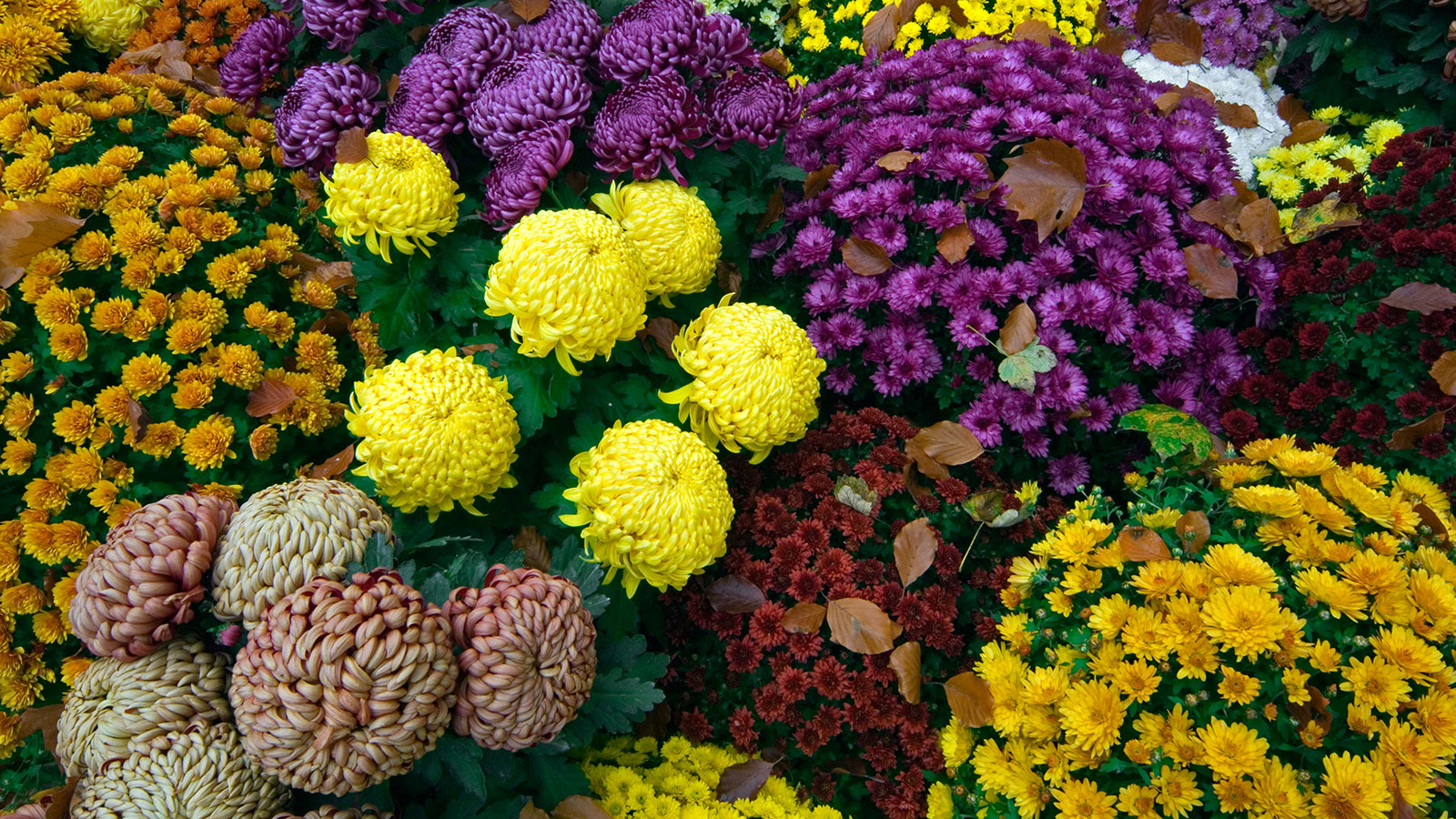
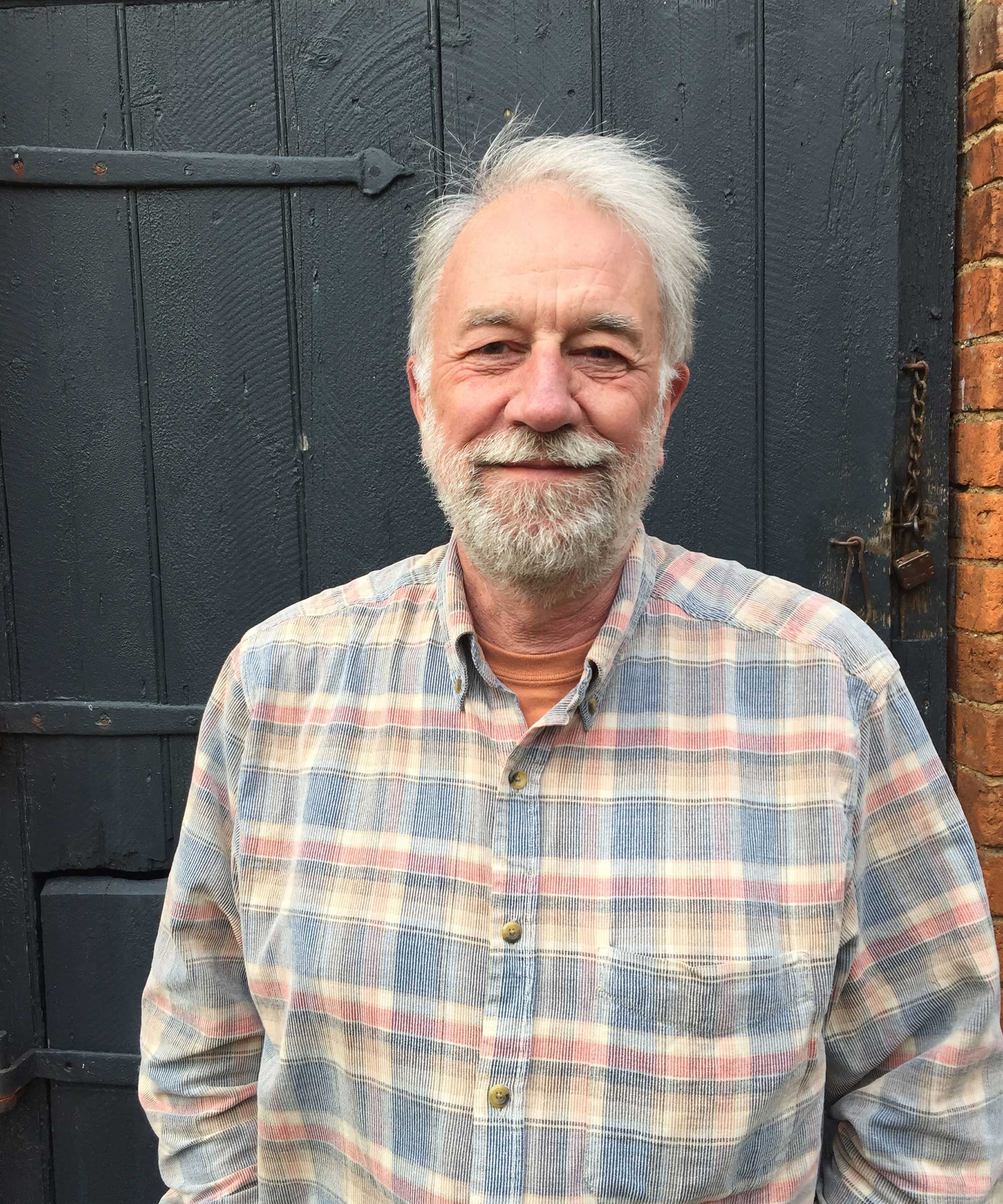
Chrysanthemums – mums, as they are often known – are perennial members of the daisy family and one of the most striking plants for late summer and early fall. At their simplest, the flowers are like huge daisies with a ring of long, flat narrow petals, surrounding a button of tiny yellow petals. From this simple start, many different flower forms have developed, most of which are based on those tiny yellow petals in the center taking on the shape of the petals in the ring around the edge.
Chrysanthemums vary in their hardiness, from being winter hardy in our coldest zones to needing frost protection through the winter. Some are grown as hardy perennials to add color and brightness to flower bed ideas. Some make neat domes of color, ideal for planting in containers. Some are grown specifically as cutting garden flowers, either outdoors or in the protection of hoop houses or a greenhouse. Some enthusiasts keep up the tradition of growing chrysanthemums for competitive showing.
These low-maintenance plants are particularly useful for giving a garden a boost during the fall months, as points out the experts at White Flower Farm. 'These fuss-free perennials produce tidy, dense mounds of spectacular color at a time when many plants are waning.'

Chrysanthemums come in many colors and the white and green varieties create a cool but stunning show

Graham Rice is a garden writer who has won awards for his work online, and in books and magazines, on both sides of the Atlantic. He is a member of a number of Royal Horticultural Society committees and the recipient of the 2021 Garden Media Guild Lifetime Achievement Award.
Chrysanthemums key facts
- Plant type: Hardy and half-hardy perennial
- Mature size: 1-4ft
- Soil type: Fertile, well-drained
- Soil pH: Slightly acid, neutral, slightly alkaline
- Time to plant: Spring
- Flowering time: Summer, fall
- Flower color: All except blue
- Hardiness zones: USDA Z3-8
- Scientific name: Chrysanthemum
- Common name: Mums
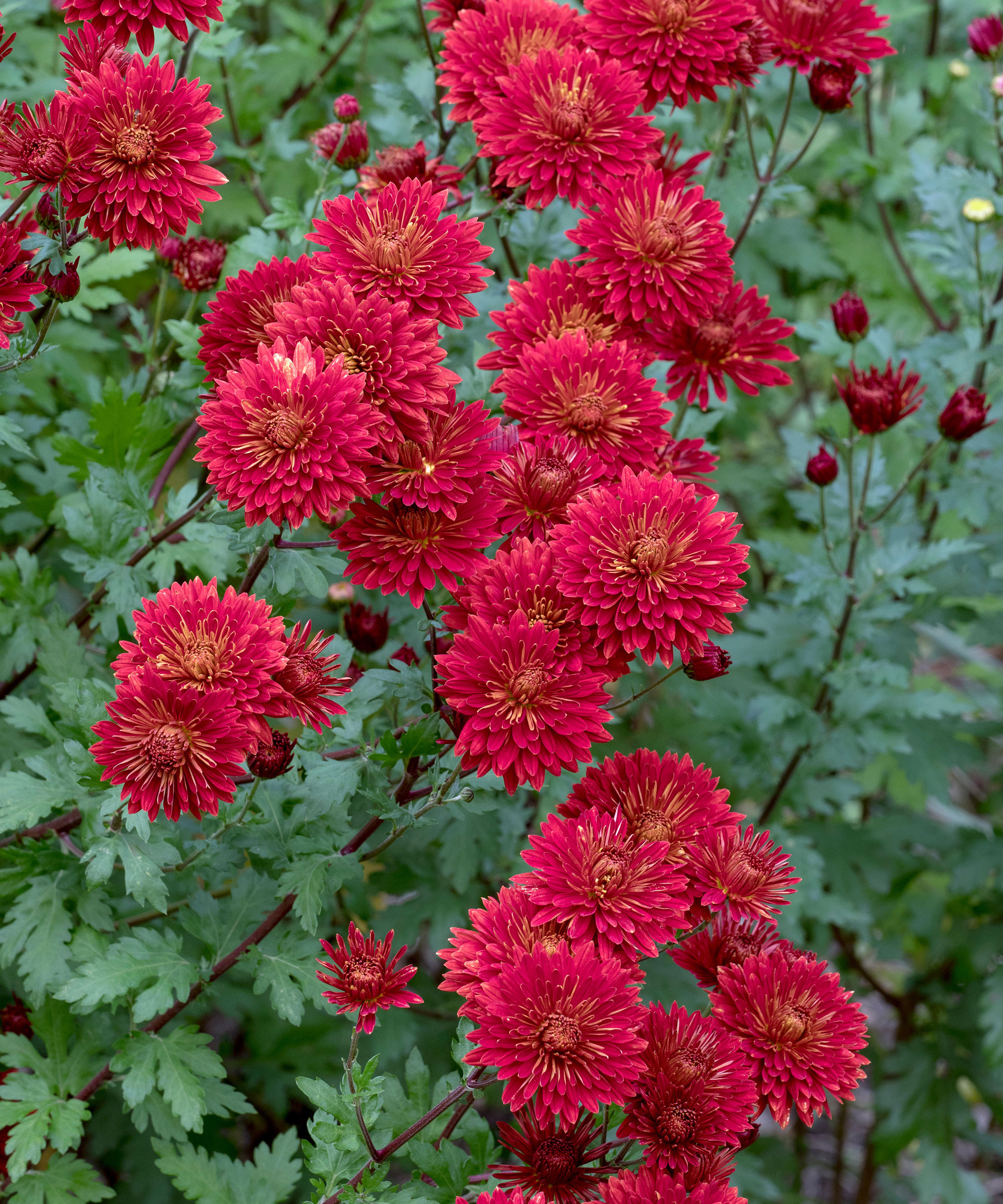
‘Brennpunkt’ is a robust, upright variety of chrysanthemum and produces warm red flowers
Different kinds of chrysanthemums
- Garden chrysanthemums: Garden mums are grown as hardy perennials, outside in the flower garden. They vary in their winter hardiness so it pays to match the hardiness of the variety to your own hardiness zone. The experts at Portland Nursery say: 'The most popular chrysanthemums are the ones known as garden mums. These robust beauties bring color to the late summer or fall garden when it needs it most. Garden mums are low maintenance, carefree, inexpensive, instant fillers in a range of vibrant colors.'
- Cut flower chrysanthemums: If you want a cut flower garden, chrysanthemums are a wonderful addition. They make long-lasting cut flowers and are widely grown, either in the open or under protection. Those sold in grocery stores are often imported, but more are now being grown at home. To cut flowers for the vase, use sharp, clean snips, such as these Growneer ones from Amazon, and always clean the sap off the blades after use.
- Pot chrysanthemums: These are dome-shaped plants grown as specimens for stunning displays in the fall. Set them out on the sides of steps and along garden paths, and on the deck, or patio. Or, use them as part of your porch decor. They give weeks of consistent color and are then composted at the end of the season.
- Show chrysanthemums: These are varieties grown specifically for entering into competitions at flower shows. Varieties are chosen from among other types or, more often, developed specifically for showing using special growing techniques.
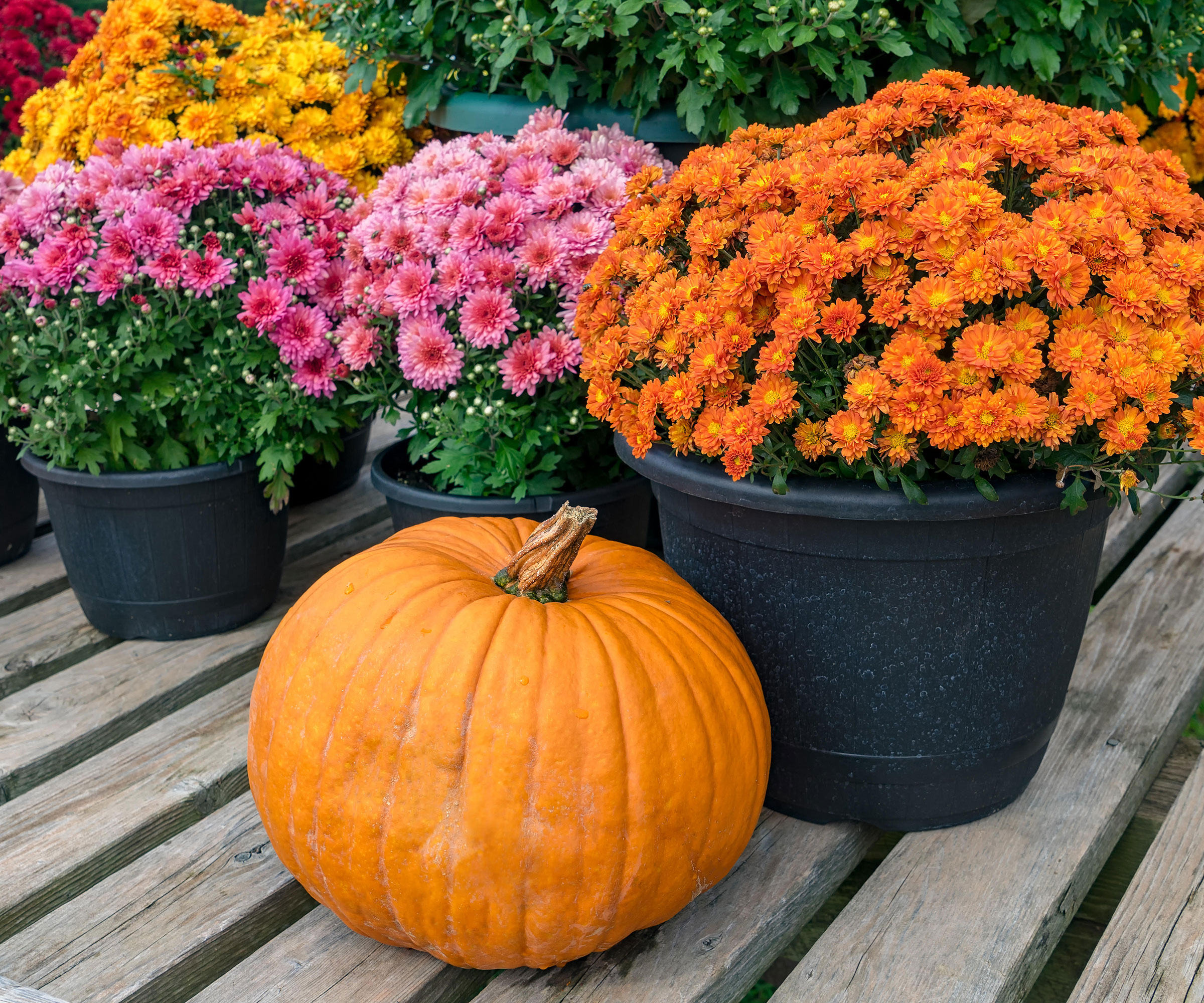
Use chrysanthemums to make a colorful potted display
How to choose chrysanthemums
Choose pot chrysanthemums by the size of the plants, and the color of the flowers. Plants which are coming into flower and showing plenty of color in their buds but are not fully open will provide color for the longest period.
Garden, show and cut-flower chrysanthemums come in a number of different flower forms:
- Incurved: Large double flowers with the petals curved upwards towards the center to almost make a ball.
- Reflex: Large double flowers with the petals rolled downwards.
- Pompons: Small flowers with petals tightly packed into balls.
- Single: The flowers are like daisies, with a ring of petals around a golden center.
- Spoon: Daisy-like flowers with the petals rolled into a tube, except at the tips which are flattened.
- Quill: The daisy-like flowers have each petal rolled into a tube.
- Spider: Each flower is an exotic mass of slender petals, often hooked at the tip.
- Decorative: The slightly flattened, double flowers are more open than other doubles.
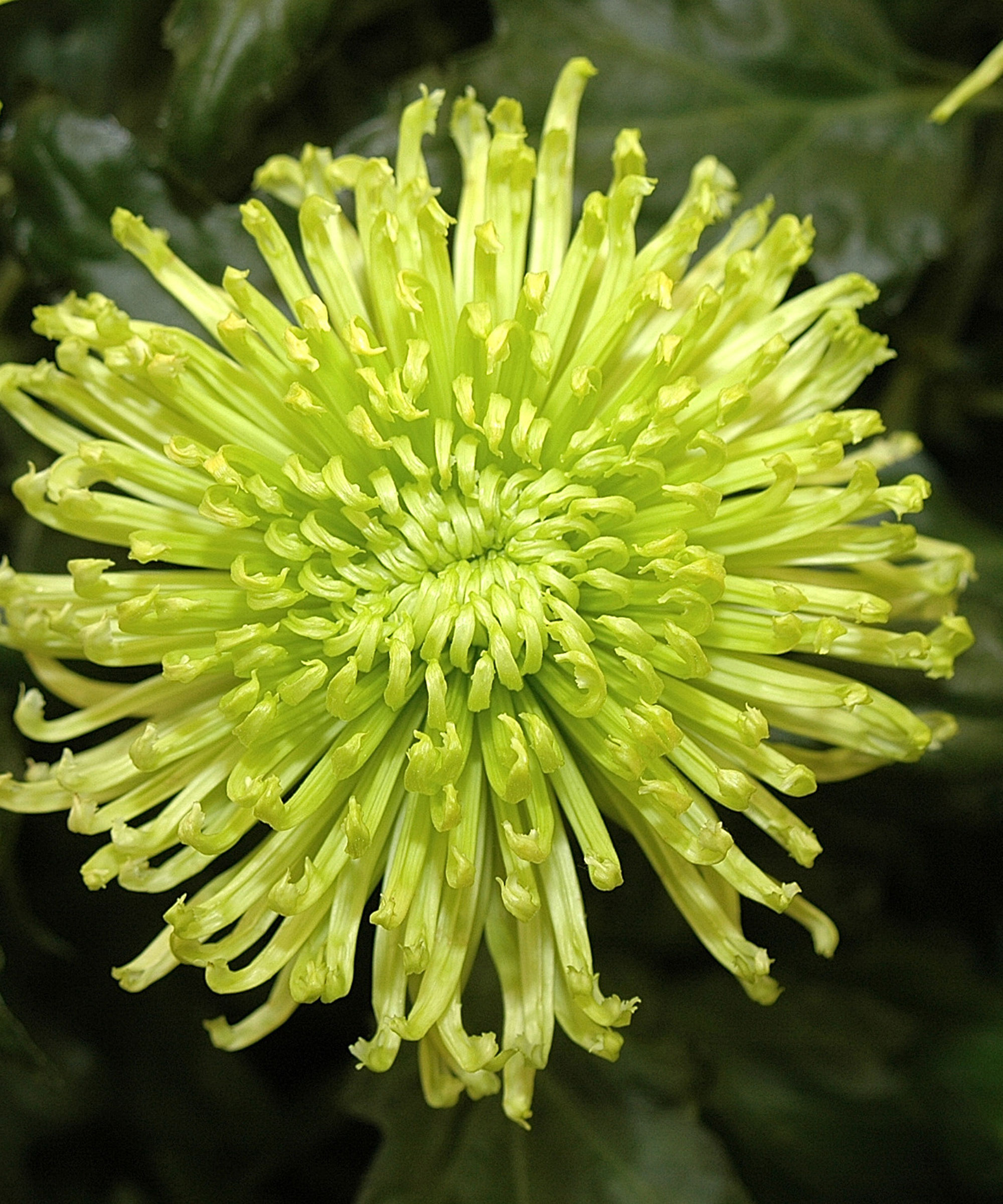
The distinctive double quilled spider form, ‘Anastasia Green’
How and where to plant chrysanthemums
Any fertile, well-drained soil in a sun-filled backyard suits chrysanthemums.
Rooted cuttings are too small to plant directly in the garden, so set them individually in 4in pots of fresh, moist potting soil, such as Wonder Soil from Amazon. Grow them on in a sunny sheltered place outside, or in a porch, until roots emerge from the drainage holes in the pot. Ideally, plant just after the last frost in your area.
Young plants will usually be shipped to arrive at the right planting time in your area. If frost still threatens when they arrive, wait.
Pot mums are usually grown on at home in the pots in which they were bought – they have been developed for a one-season display. When winter finally ruins the flowers, the plants are discarded and can be added to your compost heap as part of the homemade composting process.
Pot mums can also be planted in the open ground, but are often less winter hardy than garden mums and may simply fail to re-appear the following year.
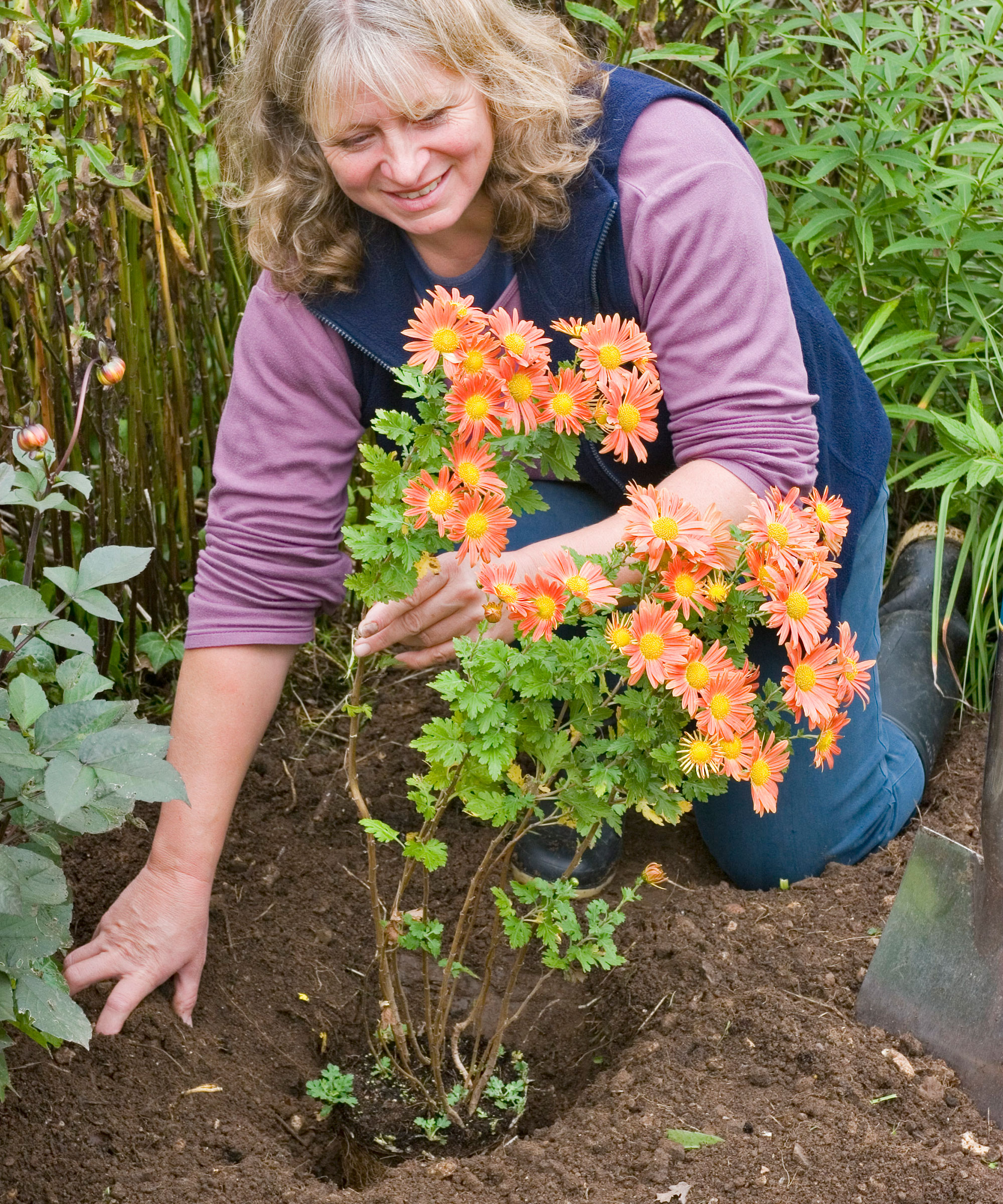
Chrysanthemums will thrive in sunny, fertile soil
How to care for chrysanthemums
- Caring for pot chrysanthemums: Water regularly to ensure that the potting soil stays damp – when set out on concrete or stone steps, the potting soil can become warm and dry out quickly. Choose a sheltered site where the pots will not blow over.
- Caring for garden chrysanthemums: Do not cut them back in the fall. Instead, cut them back to the ground in early spring. Feed with an all-purpose fertilizer, such as this one from Miracle-Gro available from Amazon, in spring, or regularly with a liquid feed such as this EZ-gro formula, also from Amazon, then mulch to retain moisture and deter weeds.
- Caring for cut flower chrysanthemums: Treat them as garden mums, and cut sprays when the flowers are mostly open. Cut large-flowered types when the flowers are half open. They can last up to two weeks in the vase.
- Caring for show chrysanthemums: Remove the side buds to develop larger flowers, and protect them from rain and winds. Cut the blooms when they're fully open. Never allow the plants to dry out. Feed during the growing season, especially if your soil is poor and needs improving. Support taller types with grow-thru frames, plant supports (try Amazon), or canes and twine.

Keep pot chrysanthemums well watered
Solving common problems with chrysanthemums
The most common problem with chrysanthemums is that they die during the winter. It can sometimes be difficult to find out if the varieties you like are winter hardy in your area and it may well be that your plants simply fail to grow in spring.
Mums also suffer from drought in summer as their roots are shallow. A spring mulch helps.
Diseases such as rust, white rust, gray mold, various leaf spots and viruses as well as mildew attack mums. Pests, including slugs, aphids, eelworms, leaf miners and mites can also cause problems. Many problems can be prevented by good cultivation, retaining moisture in the soil, and not allowing the plants to become too crowded.
Appropriate treatments for fungal diseases and common pests are available, and some chemical sprays such as this Garden Safe one from Amazon will deal with both. Check with your local nursery or extension service for advice on what is suitable for your area.

Mosts specialist nurseries offer hardy chrysanthemums. This is Mammoth 'Dark Pink Daisy’
How to buy chrysanthemums
There are many places to buy plants, but in garden centers, the garden departments of DIY stores, and other retail nurseries and outlets, including roadside plant stands and farmers’ markets, chrysanthemums are usually only available in the fall.
Pot mums are not usually available by mail order, although other types are offered either as rooted cuttings or as young plants in pint pots. Unfortunately, the number of mail-order suppliers in the US has dropped in recent years.
FAQs
Are chrysanthemums hardy?
This depends on where you are gardening and the varieties you grow. Check your hardiness zone and then match the hardiness rating of the varieties you have or would like to grow.
The rating is usually to be found on the tag or on the website or in the catalog of your supplier.
You can increase the chances of your mums coming through the winter by ensuring that their situation is well drained, that they are planted in full sun and that, apart from deadheading, the stems are left in place, well-supported, until spring.
It is universally agreed that the most resilient, winter-hardy varieties are those in the Mammoth Series. These were developed at the University of Minnesota, well known as one of the very coldest parts of the USA, and they are hardy to USDA Z3. Korean varieties are also hardier than most.
Do chrysanthemums come back every year?
Chrysanthemums are hardy perennial plants so will come back year after year if they’re growing in the right conditions.
Apart from matching the right varieties to your winter temperatures, you can encourage your mums to come back year after year by growing them in fertile, but well-drained conditions. Mums also dislike shade, so be sure to plant them in full sun.
They are also more likely to come back for another year if they have been growing well.
Plant your mums in spring, so that the plants have as long as possible to establish themselves before winter.
Also, fertilizing with a liquid feed every two or three weeks during spring and summer will set them up for the winter and encourage them to come back the following year. Cease feeding as flowering begins.
What’s the difference between a large-flowered mum and a spray?
A large-flowered chrysanthemum develops one large flower at the tip of each stem. Some varieties grow this way naturally. In others, it is necessary to select the main bud on a shoot and then remove the buds immediately below it. This diverts all the energy into developing one impressive flower. Large-flowered chrysanthemums are mainly grown as cut flowers or for showing.
Spray chrysanthemums are the opposite – they develop smaller flowers that are carried in branched sprays to create a more informal look.
Again, some varieties grow naturally as sprays. In others, branching can be stimulated by snipping off the main bud. This encourages the buds farther down the stems to develop. Many garden mums naturally develop as sprays. Sprays are also widely used as cut flowers.
Most pot mums, as well as the Mammoth varieties, naturally develop a more repeatedly branched style of growth, so the plants mature into domes of color.
Are chrysanthemums deer resistant?
No, these are not deer-resistant plants. Although they are not one of their favorites, in that they don't only eat chrysanthemums in a garden full of lots of different plants, deer will eat your mums.
Sign up to the Homes & Gardens newsletter
Design expertise in your inbox – from inspiring decorating ideas and beautiful celebrity homes to practical gardening advice and shopping round-ups.

Graham Rice is a garden writer who has won awards for his work online, and in books and magazines, on both sides of the Atlantic. He is a member of a number of Royal Horticultural Society committees and the recipient of the 2021 Garden Media Guild Lifetime Achievement Award. He gardened in Pennsylvania for 20 years, but has recently returned to his native England.
-
 Miley Cyrus breaks a cardinal decorating rule with her 'floating table' – her unexpected layout transforms a dead space into a stylish breakfast area
Miley Cyrus breaks a cardinal decorating rule with her 'floating table' – her unexpected layout transforms a dead space into a stylish breakfast areaThe singer tosses aside the maxim that furniture shouldn't be floating in the middle of the room with an innovative kitchen layout
By Sophie Edwards Published
-
 It’s a concept straight out of a fashionista's playbook, but I used the Sandwich Method to organize my kitchen shelves – it’s never looked sleeker
It’s a concept straight out of a fashionista's playbook, but I used the Sandwich Method to organize my kitchen shelves – it’s never looked sleekerIt transformed messy to mesmerizing in a matter of seconds
By Punteha van Terheyden Published